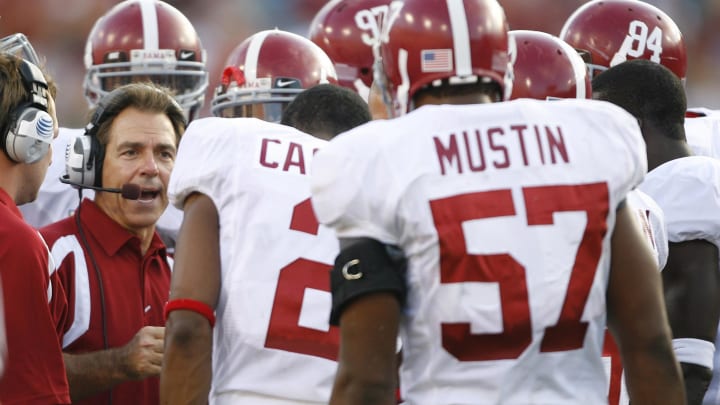2007 Alabama Football Provided a Glimpse of Something Special

On the surface, you could call the 2007 Alabama football season lackluster.
The Crimson Tide, in its first season under newly-hired head coach Nick Saban, finished the year 7-6. There were no trophies hosted outside of the Independence Bowl in Shreveport, no trips to New York for a Heisman finalist, no weeks spent at No. 1 in the AP Poll.
It was an average season. At least, average at first glance. But what the 7-6 record doesn't show is the groundwork that was laid, brick by brick, that bolstered Alabama into a decade and a half of dominance that will likely never be replicated in the sport's history.
To truly capture the changes that were taking place in and around the program, you can't simply start at the 2007 season opener against Western Carolina. Instead, let's go back to the spring of 2007, Saban's first few months in Tuscaloosa as the head man.
Saban's arrival was celebrated by Alabama fans across the state, and while they assumed they were getting a winner, the players left over from the 2006 team had to endure some major adjustments.
"He came in there and didn’t ask anybody about us, he had no previous knowledge of any of us, so everyone started with a clean slate," linebacker Eryk Anders (2006-2009) told BamaCentral. "If you were a bad guy, you could be a good guy now. It was a new opportunity for everybody, and he assured us everybody would have the opportunity to compete every day in practice. Every day was a battle for your position."
That competition that was promoted day in and day out on the practice field carried over into Saban's first spring, which eventually led into the annual A-Day game, the final scrimmage of spring practice that was open to the public.
On April 21, 2007, Tuscaloosa became a mad house for a spring scrimmage.
Fans from all over the state and beyond filled the streets of Tuscaloosa clad in crimson and white. A picture alone of the city that day could easily be mistaken for the SEC opener, or even an Iron Bowl. But this was just a spring game, and fans' first opportunity to see a Saban-coached Alabama team in action.
“It was insane. I don’t think that had ever happened before, and it remained pretty consistent every year after that," Anders said. "I think everybody was excited, the fans, the players, the boosters, the coaches. You just didn’t know what you were gonna get, but you knew he’d been a winner before, so they wanted to see him instill that winning culture from the beginning."
Rodney Orr, who covers Alabama for Tider Insider, remembers the shock he felt walking up to Bryant-Denny Stadium that day and seeing the sea of crimson that filled the areas around the stadium like a tidal wave.
"I went to the press box, and I had no idea what was fixing to happen," Orr said. "I remember sitting there saying ‘Hey there might be 70,000.’ A few minutes later, ‘There might be 75,000. There might be 85,000.’ Before you knew it, they’re hanging from the rafters. They were filling the walkways, they shut the gates, and supposedly there were 10 thousand outside lurking around. It was an incredible, incredible event."
The officially announced attendance for A-Day in 2007 was 92,138. No spring game in college football history before then had ever had a spring game attendance that size.
"This is Alabama. This is what it is. This is why I came here," cornerback Javier Arenas (2006-2009) said of the A-Day crowd. "This is why people have loved this school and this football team for so long. This is what it’s supposed to be. That was kind of my thought process behind it."
For the players, it signified what the coming gamedays in Tuscaloosa would truly look like under Saban's new regime.
"And this was just the spring game, so what are they gonna be like during the season?" Anders said. "It’s the Saban Effect, everywhere he goes, and everything he does, he’s a winner."
With that kind of fan support, the energy around the Alabama program had palpably shifted. Gone were the days of mediocre attendance to get behind a mediocre product. The Crimson Tide fanbase craved a winner, now being 15 years removed from the 1992 national championship.
"The fanbase was hungry. You can go back to when Saban arrived at the airport and the turnout they had there. This fanbase had the coach they had been waiting for," Orr said. "You just got a sense that this was what Alabama had been waiting for since Coach Bryant retired. No one could have predicted what would happen at the time, but you could sense something special was about to happen."
From the fans to the players, that day signified that change was on the horizon, and that brighter days were coming soon for the once-premiere program in college football.
"I got chill bumps just talking about this," wide receiver Mike McCoy (2006-2009) said. "But that first A-Day, when I tell you the air just smiled different. The grass was just a little greener. There was like an itch. You knew Saban had a point to prove.”
The excitement carried over into the 2007 season, a season that had plenty of ups and downs, but most notably flashed the potential of what was to come for Alabama under Saban.
The Crimson Tide knocked off a ranked Arkansas team at home in the third game of the season, a game which could easily be described as the first major win of the Saban era. But for Orr covering the team, the most notable win to him came later in the season, on the Third Saturday of October.
The Arkansas win catapulted Alabama into the top 25, setting up a ranked-on-ranked matchup with Georgia and College GameDay's first trip to Tuscaloosa under Saban. Alabama fell to the Bulldogs in overtime, before losing a second straight game the following week against Florida State.
The Crimson Tide then won consecutive games against Houston and Ole Miss, bringing a 5-2 record back home ready to play host to the Volunteers.
Alabama welcomed No. 20 Tennessee into Bryant-Denny Stadium for Saban's first meeting with the bitter cross-division rival from up north on Oct. 20, 2007. Alabama was a home underdog, and had multiple players suspended from the game.
Despite that, the Crimson Tide left Bryant-Denny having drubbed Tennessee, 41-17.
“The Tennessee game, I thought, ‘This team probably doesn’t have a chance in this game,'" Orr said. "And they just came out and dominated the game from the opening kick. They blitzed Tennessee from there. It was 41-17, Tennessee was shellshocked. We saw a glimpse there of what Alabama was going to be."
After the Tennessee game, the season took a downward turn. Five key players were suspended for four games, and the Crimson Tide lost the final four games of the regular season, losing a close game at home to eventual national champion LSU, followed by losses to Mississippi State, Louisiana-Monroe, and Auburn.
The 6-6 regular season led to a matchup with Colorado in the Independence Bowl. Not necessarily the bowl game many Alabama fans hoped for in Saban's first year, but it featured an important shift in the locker room for how Saban's teams would be run from that point forward.
"I felt like the coaches didn't really care if we had won it or not. And so the seniors kind of took it upon themselves to go out with a winning record, and we were able to do that," defensive end Wallace Gilberry (2003-2007) said. "Being the defensive MVP of that game kind of solidified my time at 'Bama.”
That player-led mentality became a staple of the Alabama football machine that came in the years following 2007. As for the fans, while the record may not have been what they'd hoped, it was clear the sun would soon be shining on the Alabama football program again.
“I think most people did understand that the first year could be difficult," Orr said. "The talent level wasn’t what it should’ve been. They expected Saban to recruit extremely well, and that things would turn. People understood that in the near future things were gonna get a lot better. Maybe not in 2008, but in the future."
Little did they expect, Alabama rose to No. 1 in the AP Poll during the 2008 season, announcing its arrival to the college football world and beginning a run that will be talked about for generations.
